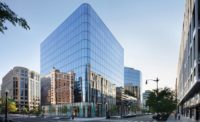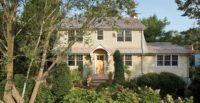North-Holland, Netherlands
A house by architect Ben van Berkel rarely could be described as a glass box. Instead the principal of the Amsterdam-based UNStudio avoids the rectilinear modernist approach for a more organic direction. Curves and swerves take charge of the parti as seen in the W.I.N.D. House, a 4,370-square-foot structure in the northwestern part of the Netherlands.
To accommodate the programmatic needs of a family living there full-time, van Berkel pinched the house into two biomorphic volumes, one for public living spaces, the other for private. Then he gouged out each of the two wings with U-shaped voids.
In plan, the result looks a bit like a carnivorous plant with four distended petals. There a family of four can find many places to retreat and enjoy the views and cross breezes. (The name of the house, W.I.N.D., actually is formed from the family’s initials.) While the living and dining areas look south to polders—reclaimed low-level land protected by dikes—the sleeping and work spaces on the north half face the woods. Because of changes in grade, the house loosely follows a split-level pattern, connected by an open steel stair.
To protect the interiors from glare, van Berkel tinted the glass and pushed back the expanses within the volume of the house to create sheltering canopies, terraces, and blinders at the sides. He also wrapped the masonry load-bearing walls in Fraké—hardwood—slats that bulge out with blob-like growths. “The shapes play off the land forms,” says van Berkel, noting that they filter light to the spaces within.
In order to keep the house energy-efficient, the architect installed a system to regulate power usage, along with a battery of other sustainability elements, including pvs on part of the roof, a central air/water heat pump, and mechanical ventilation with waste-heat recovery. Such advantages matter greatly to both client and architect. But just as significant to the design was the desire for a residence that dynamically embraced the natural surroundings while being discreetly immersed in the landscape.
PeopleArchitect: Personnel in architect's firm who should receive special credit: Interior designer: UNStudio, Tim-Alkmaar Engineer: Pieters Bouwtechniek, Haarlem Consultants: Lighting: Elektrokern Solutions, Alkmaar Acoustical: Hans Koomans Studio Design, Amsterdam Site Management: Studio Bouwhaven bv., Barendrecht Tender Documents: Adviesbureau Both, Haarlem General contractor: Architectural: Bouwbedrijf MJ De Nijs en ZN bv., Warmenhuizen; MEP: BAM Techniek, Benningbroek Photographers: Fedde de Weert (exterior) Gross square footage: 528 m² Total construction cost: Withheld Completion date: 2014 |
ProductsStructural system Windows: Kumasol Minimal windows, Kumasol, Etten-Leur Flooring: PU self levelling flooring screed, Senso, Rhenen Ceilings: Clay rendering, Tierrafino, Amsterdam Flooring: PU self levelling flooring screed, Senso, Rhenen Ceilings: Clay rendering, Tierrafino, Amsterdam Wall finishes: Clay Rendering, Tierrafino, Amsterdam; Hamam: Tadelakt, Tierrafino, Amsterdam Lighting: Outdoor floor spots: Bega 8671 Ceiling spots: Delta light Diro 126 Eating Table: Norman-Copenhagen Bell Appliances / special elements: Bathroom appliances: Grohe Axor Massaud Fixtures and fittings: Vola Carpentry: Tim-Alkmaar, Alkmaar, The Netherlands Special elements: Podium Living room: Moso bamboo, Zwaag, The Netherlands Furniture: Furniture supplied by Co van der Horst, Amstelveen: Kitchen table: B&B Italia, Seven Kitchen chairs: MDF Italia, Flow Chair Sofa: Flexform, Evergreen Low table: Leolux, Cimber Carpet: Perletta Carpets Outdoor furniture: B&B Italia, Canasta Other unique products that contribute to sustainability: Energy / Power generation: PV-cells on the roofs of the two wings at the back of the house Indoor Climate: use of natural materials such as clay stucco finishing’s for all walls and ceilings, permeable to water, vapor, avoiding chemical evaporation, and wood as façade cladding, natural tadelakt for the Hamam |








